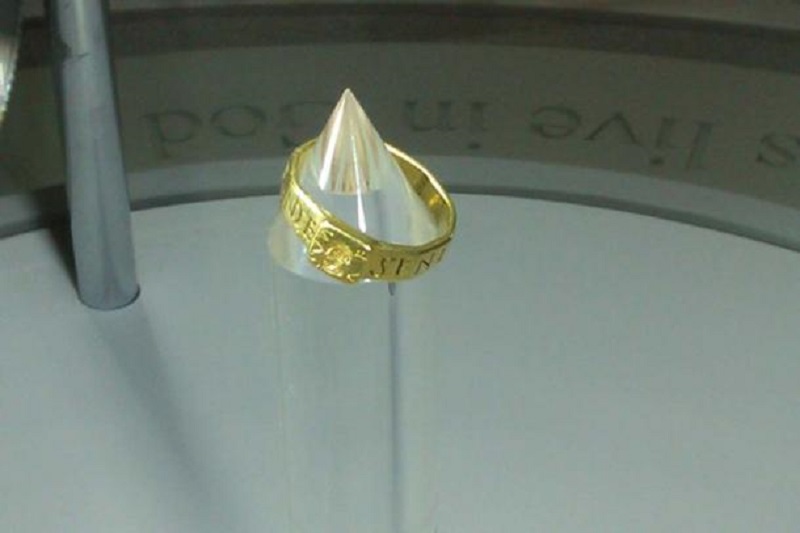Today, there are many Roman gold and silver rings on display in museums and archives. However, there is one Roman ring that stands out as legendary. Known as the Ring of Senicianus, the Ring of Silvianus or the Ring of Vyne, this golden ring was stolen over 1600 years ago. The owner asked the gods to curse the thief and whoever owned it. Owned by the National Trust today and on display at Vyne Manner, this gold ring may have been the inspiration for JRR Tolkien’s One Ring in The Hobbit.
Sometime in the 4th century AD, Silvianus, a Roman stationed in Gloucestershire, England, visited the elaborate baths of the Celtic God Nodens. Perched on a hill above the River Severn in Lydney, the Temple of Nodens honors the Romano-British god associated with healing, hunting, dogs and the sea.
Bathhouse at the temple complex. ( CC BY-SA 2.0 )
Nodens is cognate with the ancient Irish Nuada Airgetlam, the first king of the Tuatha de Danann, who was removed from rule of Ireland because he was defeated in battle. Nodens are also associated with the Arthurian legend of the Fisher King, the Norse god Njord of the Vanir (god of wine, fishing, sailing and fertile lands along the coast) and the Roman god Mars. By all accounts, Nodens may be a mischievous deity and very inclined to help lift the curse.
Njörd’s Sea Desire (1908) by WG Collingwood (Public Domain)
While Silvianus was at the Temple, his gold ring was stolen. Silvianus believed that it was Senicianus who stole the ring – how he knew this is unclear. Silvianus therefore went to the Temple and prepared a lead plate known as the defixio or ‘table of curses’. He engraved on the tablet in Latin:
DEVO NODENTI SILVIANVS ANILVM PERDEDIT DEMEDIAM PARTEM DONAVIT NODENTI INTER QVIBVS NOMEN SENICIANI NOLLIS PETMITTAS SANITATEM DONEC PERFERA VSQVE TEMPLVM DENTIS
Translated as
Dedicated to the god Nodens. Silvianus lost a ring and gave half [of its value] to Nodens. Among the people named Senicianus was not in good health until it was returned to the temple of Nodens.
This ring is large, perhaps meant to be worn on the thumb or outside a glove. It is 1 inch (25mm) in diameter and weighs 12 grams (0.4oz). The ring has ten sides and a square bezel engraved with the Roman goddess Venus. When the pagan Silvianus took possession of the ring, all ten gold sides were bare. However, a later Christian owner, probably Senicianus, crudely engraved the ring with the words “SENICIANE VIVAS IIN DE”. Perhaps, the writer wanted to say “SENICIANE VIVAS IN DEO” or “Senicianus, may you live with God”, however, he misspelled ‘IN’ with two Is and thus there was no room for the word O in DEO.
Little is known about Senicianus’s fate. The ring was discovered in 1785 in a plowed field on a farm near Silchester, England. Silchester is a town of Roman origin, about 100 miles from Lydney. Some researchers say that the ring was accidentally lost, others that it was thrown away on purpose. Falling on hard times, the Silchester farmer sold the ring to the Chute family who lived in a nearby country house, The Vyne. The Chute people were known to be interested in history and antiquities, however, it was not until 1888 that Chaloner Chute noticed the ring and published an article about it. And it was not until 1929 that the connection between the Vyne ring and Silvianus’ curse tablet was established by archaeologist Sir Mortimer Wheeler. However, this connection cannot be completely confirmed, Senicianus is an unusual name and the close dating of the artifacts seems to support Wheeler’s theory.
The ring of Senicianus. ( nolongerinlondon.wordpress.com )
JRR Tolkien, at the time just a professor of Anglo-Saxon and Celtic literature at Oxford University, was asked by his friend Wheeler to help clarify who the obscure god Nodens was and what role he might play. nothing in the history of the Ring.z
Many people now believe that the Ring of Senicianus was the inspiration for the ring in The Hobbit. In an article published in History Today, Mark Horton, professor of Archeology at the University of Bristol, and Dr Lynn Forest-Hill, Education Officer of the Tolkien Society, explain:
Silvianus lost his golden ring at Lydney, just as Gollum lost his under the Misty Mountains. Silvianus believed his ring had been stolen by someone whose name he knew – Senicianus – just as Gollum thought his ring had been stolen by Bilbo Baggins. Silvianus cursed the name of the person he suspected. Likewise, when Gollum discovers that Bilbo has found and kept his ring, he screams in rage: ‘Thief, thief, thief! Baggins! We hate it, we hate it, we hate it forever!’ Both Gollum and Silvianus knew the identities of those they considered the thieves who had stolen their gold rings, and both claimed these names with curses.
An artist’s impression of Gollum by Frederic Bennett. ( CC BY-SA 4.0 )
It’s important to remember that the ring in The Hobbit (1937), which gives the wearer invisibility, is different from the ring in The Lord of the Rings (1954-55), which gives the wearer vision uniqueness, long life and untold strength. Author J.R.R. Tolkien acknowledged the discrepancy, writing, “The only freedom… is to make Bilbo’s Ring the One Ring: all the rings have the same source, before he laid his hand on it. it’s in the dark.”






